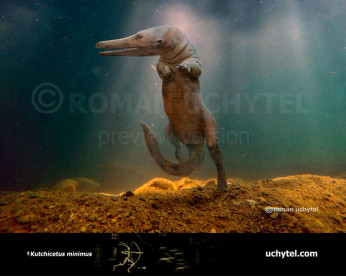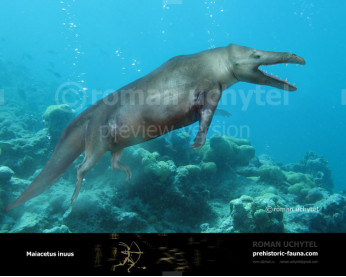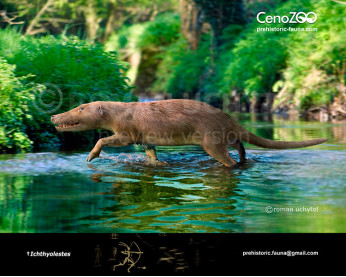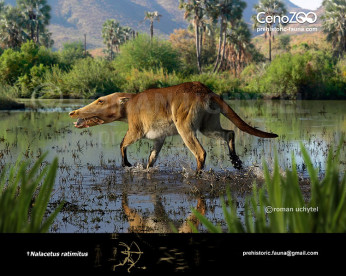Rodhocetus
305305Rodhocetus (†Rodhocetus Gingerich et al. 1994)
Order: Cetacea
Suborder: Archaeoceti
Family:†Protocetidae
Temporal range: from the Mid Eocene (47 to 41 million years ago) of Pakistan
Dimensions: length - 2,5 m, weight - 250-300 kg
A typical representative: Rodhocetus kasrani
Rodhocetus (from Rodho, the geological anticline at the type locality, and cetus, Latin for whale) is an extinct genus of protocetid early whale known from the Lutetian (48.6 to 40.4 million years ago) of Pakistan. The best-known protocetid, Rodhocetus is known from two partial skeletons that taken together give a complete image of an Eocene whale that had short limbs with long hands and feet that were probably webbed and a sacrum that was immobile with four partially fused sacral vertebrae. It is one of several extinct whale genera that possess land mammal characteristics, thus demonstrating the evolutionary transition from land to sea.
Throughout the 1990s, a close relationship between cetaceans and mesonychids, an extinct group of cursorial, wolf-like ungulates, was generally accepted based on morphological analyses. In the late 1990s, however, cladistic analyses based on molecular data clearly placed Cetacea within the Artiodactyla near the hippopotamus. One of the diagnostic characters of artiodactyls are the double-pulley astragalus (heel bone) and palaeontologists, unconvinced by the data from the labs, set themselves out to find archaeocete single-pulley heel bones. Hind legs from three archaeocete species were recovered within a few years, among them those of Rodhocetus balochistanensis, and these cetaceans all had double-pulley heel bones — the cladistic controversy was finally settled.
Through a principal components analysis Gingerich 2003 demonstrated that Rodhocetus had trunk and limb proportions similar to the Russian desman, a foot-powered swimmer using its tail mainly as a rudder. From this Gingerich concluded that Rodhocetus was swimming mostly at the surface by alternate strokes of its hind feet, and that it was insulated by fur rather than blubber, as are Dorudon and modern cetaceans, which made it buoyant and incapable of deep diving.
The holotype of R. kasrani, GSP-UM 3012 found in 1992, was described by Gingerich et al. 1994: a cranium with two dentaries, most of the vertebral column as far as the anterior tail (C2–C7; T1–13; L1–6, S1–4, Ca1–4), most ribs, parts of the sternum, both hip bones, and a left femur. Gingerich et al. 1994 referred a specimen collected in 1981, GSP-UM 1852 two dentaries with teeth, to R. kasrani.
Derived traits in R. kasrani, relative to older archaeocetes such as Pakicetus, includes high-crowned cheek teeth, larger auditory bullae, larger mandibular foramen, and mandibular canals. The higher neural spines and shorter femur (60–70%) distinguishes Rodhocetus from the more primitive Ambulocetus. The convex posterior surface of the exoccipital, shorter cervical vertebrae, and unfused sacral vertebrae distinguishes R. kasrani from Indocetus. In contrast to later archaeocetes such as Protocetus and later cetaceans, Rodhocetus retains external nares above upper canines, high neural spines on anterior thoracic vertebrae, and four sacral vertebrae with sacroiliac joints similar to those in land-mammals (suggesting a hip joint that could support the body weight.).
Several cranial features identifies R. kasrani as an archaeocete: both the premaxillae and the dentaries are elongated, the frontal shield is wide, and the nuchal crest is high. The auditory bullae are large and dense but, there are no associated pterygoid fossae or air sinuses. The mandibular foramina are large with a pan bone 90 mm long and 65 mm high.
The specific name kasrani comes from Qaisrani, the Baloch tribe inhabiting the type locality. The protocetid Qaisracetus is also named after them.
From Wikipedia, the free encyclopedia
Rodhocetus (†Rodhocetus Gingerich et al. 1994)
Order: Cetacea
Suborder: Archaeoceti
Family:†Protocetidae
Temporal range: from the Mid Eocene (47 to 41 million years ago) of Pakistan
Dimensions: length - 2,5 m, weight - 250-300 kg
A typical representative: Rodhocetus kasrani
Rodhocetus (from Rodho, the geological anticline at the type locality, and cetus, Latin for whale) is an extinct genus of protocetid early whale known from the Lutetian (48.6 to 40.4 million years ago) of Pakistan. The best-known protocetid, Rodhocetus is known from two partial skeletons that taken together give a complete image of an Eocene whale that had short limbs with long hands and feet that were probably webbed and a sacrum that was immobile with four partially fused sacral vertebrae. It is one of several extinct whale genera that possess land mammal characteristics, thus demonstrating the evolutionary transition from land to sea.
Throughout the 1990s, a close relationship between cetaceans and mesonychids, an extinct group of cursorial, wolf-like ungulates, was generally accepted based on morphological analyses. In the late 1990s, however, cladistic analyses based on molecular data clearly placed Cetacea within the Artiodactyla near the hippopotamus. One of the diagnostic characters of artiodactyls are the double-pulley astragalus (heel bone) and palaeontologists, unconvinced by the data from the labs, set themselves out to find archaeocete single-pulley heel bones. Hind legs from three archaeocete species were recovered within a few years, among them those of Rodhocetus balochistanensis, and these cetaceans all had double-pulley heel bones — the cladistic controversy was finally settled.
Through a principal components analysis Gingerich 2003 demonstrated that Rodhocetus had trunk and limb proportions similar to the Russian desman, a foot-powered swimmer using its tail mainly as a rudder. From this Gingerich concluded that Rodhocetus was swimming mostly at the surface by alternate strokes of its hind feet, and that it was insulated by fur rather than blubber, as are Dorudon and modern cetaceans, which made it buoyant and incapable of deep diving.
The holotype of R. kasrani, GSP-UM 3012 found in 1992, was described by Gingerich et al. 1994: a cranium with two dentaries, most of the vertebral column as far as the anterior tail (C2–C7; T1–13; L1–6, S1–4, Ca1–4), most ribs, parts of the sternum, both hip bones, and a left femur. Gingerich et al. 1994 referred a specimen collected in 1981, GSP-UM 1852 two dentaries with teeth, to R. kasrani.
Derived traits in R. kasrani, relative to older archaeocetes such as Pakicetus, includes high-crowned cheek teeth, larger auditory bullae, larger mandibular foramen, and mandibular canals. The higher neural spines and shorter femur (60–70%) distinguishes Rodhocetus from the more primitive Ambulocetus. The convex posterior surface of the exoccipital, shorter cervical vertebrae, and unfused sacral vertebrae distinguishes R. kasrani from Indocetus. In contrast to later archaeocetes such as Protocetus and later cetaceans, Rodhocetus retains external nares above upper canines, high neural spines on anterior thoracic vertebrae, and four sacral vertebrae with sacroiliac joints similar to those in land-mammals (suggesting a hip joint that could support the body weight.).
Several cranial features identifies R. kasrani as an archaeocete: both the premaxillae and the dentaries are elongated, the frontal shield is wide, and the nuchal crest is high. The auditory bullae are large and dense but, there are no associated pterygoid fossae or air sinuses. The mandibular foramina are large with a pan bone 90 mm long and 65 mm high.
The specific name kasrani comes from Qaisrani, the Baloch tribe inhabiting the type locality. The protocetid Qaisracetus is also named after them.
From Wikipedia, the free encyclopedia

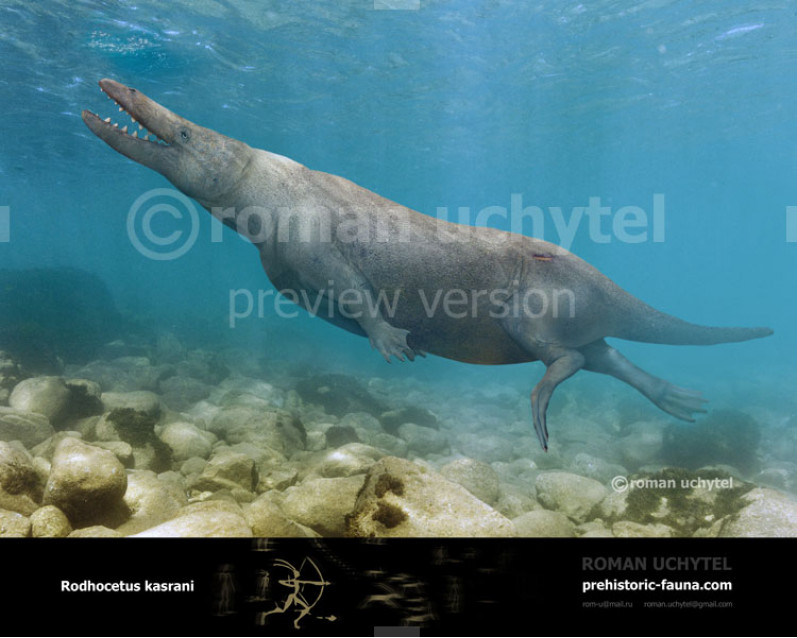
-797x638.jpg)
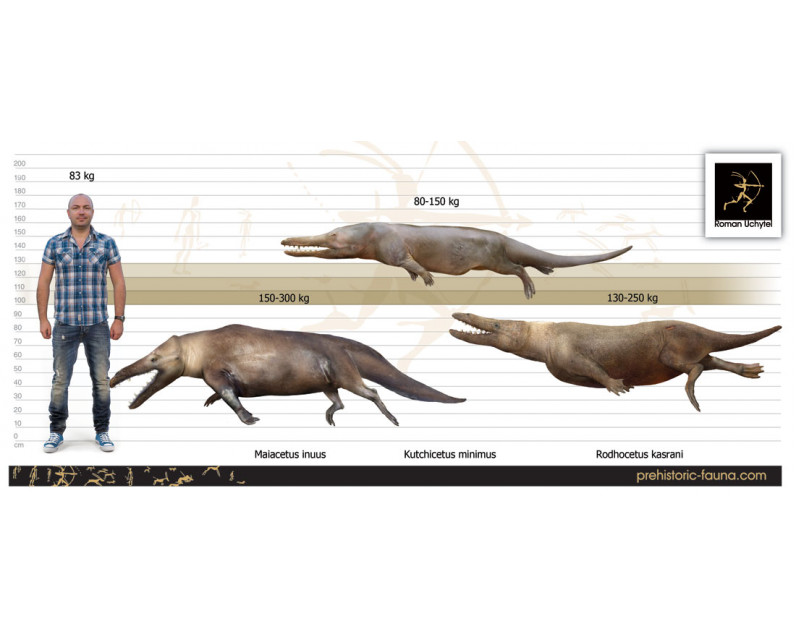

-70x56.jpg)

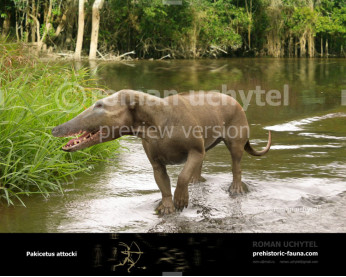
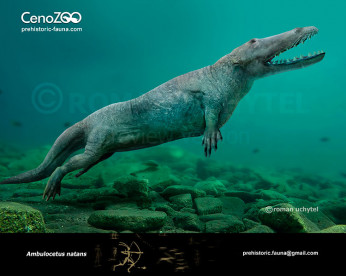
-346x277.jpg)
